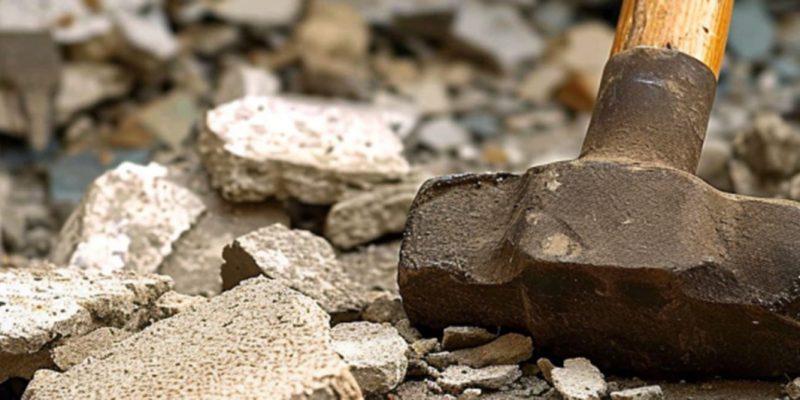Planning to break up some concrete at your place? Whether it’s a small garden walkway or a bigger driveway project, understanding the right way to do it is key. In this guide, we’ll walk you through everything you need to know – from preparation to cleanup – to make your concrete breaking project a success.
Understanding Concrete in Des Moines
Concrete is super tough – that’s why we use it for so many things around our homes. But did you know, in Des Moines, our unique weather can affect how concrete behaves? Sometimes it gets really cold, which can make concrete tougher to break.
We usually see two types of concrete around our homes: the kind that’s used for building things like our driveways or patios, and the kind that’s a bit lighter, used for decorative stuff. The heavier, thicker concrete is a bit harder to break, but don’t worry, we’ll show you how to tackle both types.
Whether it’s a thick slab for your car to park on, or a thin, fancy walkway, knowing what kind of concrete you have helps you plan better for your project.
Checking Utilities Before Breaking Concrete
Before you start swinging that sledgehammer, there’s a super important step: checking for hidden utilities. Imagine accidentally hitting a water pipe or a gas line – yikes! That’s why it’s crucial to find out what’s underneath the concrete.
So, how do you do this? In Des Moines, there are utility locating services that can help. They use special tools to look under the ground and find things like water pipes, gas lines, or electric cables. This step is a must-do to avoid any dangerous surprises.
If they find something under your concrete, don’t worry. They’ll give you advice on what to do next. Sometimes, you might have to change your plans a bit, but it’s all about keeping you and your home safe.
Preparations Before Breaking Concrete
Alright, now that we’ve checked for utilities, it’s time to get ready to break some concrete. First, think about how big your project is. Is it a small path in your garden or a big ol’ driveway? The size of your project decides what tools you’ll need and how much work it’s gonna be.
Safety is super important here. You need to wear the right gear: tough gloves, goggles, and sturdy boots. Trust me, you don’t want any flying concrete chips hitting you!
Mark the area you want to break with some chalk or tape. This helps you stay on track and not break more than you need to. And, if you have pets or kids, make sure they’re far away from the work area. Safety first!
Legal and Environmental Considerations
Now, let’s talk about rules and nature. In Des Moines, before you start breaking concrete, you might need a permit, especially for big projects. Check with your local government to see if you need one. It’s always better to be safe than sorry!
Also, think about where all that broken concrete will go. We love our city and want to keep it green, right? So, let’s make sure we get rid of the concrete pieces in a way that’s kind to our environment. You can recycle most concrete, which is a great way to help our planet.
Tools and Equipment Needed
Time to talk tools! For smaller jobs, a good old sledgehammer might be all you need. But for bigger areas, consider renting a jackhammer – it’s a real time-saver. Des Moines has plenty of places where you can rent these tools, so don’t worry about buying them if you don’t plan to use them often.
Here’s a quick list of what you might need:
- Sledgehammer: Great for small jobs.
- Jackhammer: Perfect for larger, thicker concrete.
- Wheelbarrow: To carry away broken concrete pieces.
- Shovel: For cleaning up smaller debris.
- Safety Gear: Gloves, goggles, and boots.
TIP
Deciding whether to rent or buy depends on how often you think you’ll use these tools. If it’s just a one-time project, renting is probably your best bet.
Step-by-Step Guide to Breaking Concrete
Alright, let’s break some concrete! Here’s a step-by-step guide:
- Mark the Area: Use chalk or tape to mark where you want to break. This keeps you focused and prevents unnecessary breaking.
- Gear Up: Put on your safety gear – gloves, goggles, and boots.
- Start Small: Begin with a sledgehammer for smaller areas. Hit the concrete at the same spot to create a crack, then work your way around it.
- Using a Jackhammer: For bigger jobs, turn on the jackhammer and let it do its magic. Hold it firmly and start at the edge of the marked area.
- Break It Up: Keep breaking the concrete into smaller, manageable pieces.
- Clean as You Go: Use a shovel to move broken pieces into a wheelbarrow. This keeps your work area safe and tidy.
- Disposal: Remember, we want to be kind to the environment. Take the broken concrete to a recycling center if possible.
Breaking concrete can be tough, but with patience and the right tools, you can get it done!
Post-Breakage Considerations
Once you’ve broken up all the concrete, it’s time to clean up. Make sure you pick up all the pieces and check the area for any missed spots. You want to leave the area nice and safe for everyone.
If you’re planning to put something new in place of the concrete, like maybe a garden, patio or a new walkway, now’s the time to get it ready. Clear the area, level it out, and you’re all set for your next project.
Conclusion
And there you have it! Breaking up concrete might seem like a big task, but with the right preparation and tools, you can totally do it. Just remember to stay safe, follow the rules, and think about our environment. Happy breaking!

